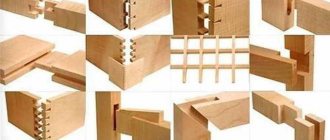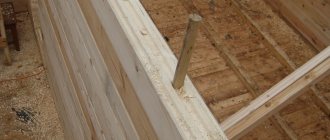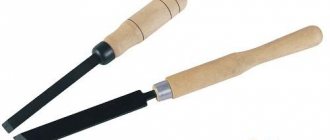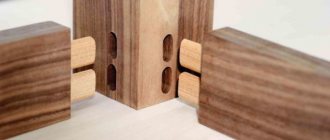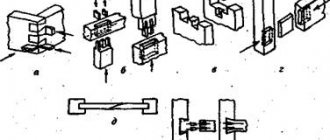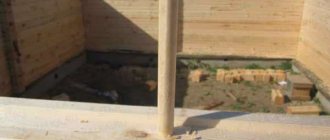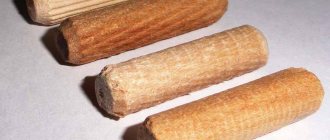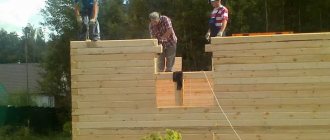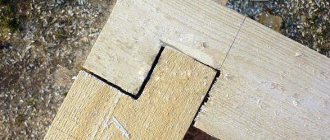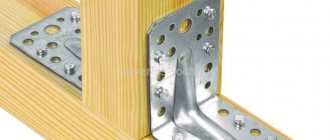Connecting parts is one of the main and, very important, labor-intensive operations. In carpentry and carpentry, there are many ways to connect parts into panels, bars, frames and boxes. Ultimately it all depends on what you need. If you need to make a shield, then you need to connect the parts with their sides; if you need a longer bar than the ones you have, you will have to connect the parts lengthwise, etc.
The purpose of the product plays an important role here. When you choose the type of connection, you should always consider what the load on the product will be and what nature it will have.
A true professional always knows what needs to be done in each specific case, i.e. what will be enough, what will be superfluous, and what to do is simply unacceptable, since the quality of the product will suffer.
The types of connections can be selected depending on the method of connection and the use of auxiliary means used to make these connections.
Classification of compounds in furniture products
The joining of elements into a furniture product is carried out in various ways. The choice of connection options is quite diverse. The designer, when choosing this or that connection, must remember that it must ensure the reliability and durability of the product, its manufacturability and aesthetics.
All used connections are divided into two main types: permanent and detachable.
Permanent connections do not require disassembly of the structure; The elements in them are connected using glue, nails, staples and screwless fittings. Detachable connections allow you to assemble and disassemble the structure.
Detachable connections are divided into stationary and movable. Stationary connections ensure a constant relative position of the connected parts of the furniture product. These include connections using ties, screws, and dowels without glue. Detachable movable joints ensure the movement of product elements relative to each other in a given direction. Movable joints include joints on hinges, rollers, and guides.
The strength of products depends on the strength of the connection between the parts. A variety of compounds are used in carpentry:
- tenon joints with glue;
- joints without spikes on glue;
- connections with screws, clamps, bolts, dowels, etc.
Rally
To get a wider wooden piece, you can also use dowels, but in a different way. Join two pieces of wood of the same thickness, align the ends of the boards and clamp them in a vice. Rallying is the best option for making massive wooden blanks and shields. Before clamping the boards with a vice, glue them with special glue for woodworking or fasten them with screws.
PHOTO: YouTube.com On a clean edge, draw two perpendicular lines in advance. Try to make them the same thickness. Then make cross marks in the middle of the edge using a thicknesser
After you have drawn all the lines, several intersection points will appear on the board - in these places you need to make holes for the dowels
If it is important for you to prevent transverse warping on the workpiece, use tips and keys
Permanent connections
The most common group of permanent connections are connections using glue. Thanks to them, structures of various shapes and purposes are created. Adhesive joints have a number of positive qualities: they are quite technologically advanced, have high strength, increase dimensional stability, and reduce the likelihood of cracking.
Tenon joints are widely used in furniture products. The main elements of tenon joints are a tenon, a socket, an eye, a tongue and a tongue.
A tenon is a protrusion at the end of a part that has a certain shape and size. The tenon fits into a socket, eye, or tongue.
A socket is a hole or depression in a part.
An eye is a hole at the end of a part, open on two or three sides. The shape and dimensions of the spike correspond to the shape and dimensions of the socket or eye.
A tongue (groove) is a recess in a part along its entire length.
A ridge is a protruding part of a part that matches the shape and size of a tongue. The main elements of tenon joints are shown in Figure 1.
Rice. 1. Elements of tenon joints: 1 – flat tenon; 2 – nest; 3 – eye; 4 – end face of the tenon; 5 – tenon shoulders; 6 – side edges of the spike; 7 – ridge; 8 – groove; 9 – round insert tenon (dowel)
The shape of the spikes is flat, round, trapezoidal (“dovetail”) and jagged. Spikes can be solid (made directly at the end of the part) or inserted (being independent parts). Inserted round tenons are called dowels. The planes of the lateral edges of the spines are called cheeks.
The ledges that form the transition from the bar to the body of the tenon are called shoulders.
The length of the tenon is the distance from its end face to the shoulders, its thickness is the distance between the cheeks of the tenon, the width is the transverse size of the cheek.
With the help of spikes they form connections:
- corner end;
- angular middle;
- corner box;
- along the length and along the edges.
Tenon joints are:
- through (the end of the tenon extends onto the visible surface with its end edge);
- open (after connection, the surface of the upper edge of the tenon becomes visible);
- with darkness (after connection, all side edges of the tenon become invisible);
- with semi-darkness (after connection, only part of the upper edge of the tenon is visible);
- on a straight tenon (the edges of the tenon joint elements are mutually perpendicular);
- miterwise (the end faces of the joined bars are cut at an acute angle - most often at an angle of 45°).
The main types of tenon joints and their dimensional relationship are regulated by GOST 9330-76 (Fig. 2, 3).
Rice. 2. Main characteristics of tenon joints: tenon design: 1 – solid; 4, 6 – plug-in; number of spikes: 1 – single; 2 – double; tenon axis direction: 1, 2 – straight; 5 – oblique; spike shape: 1, 2, 5 – flat; 3 – “dovetail”; 6 – round; corner end connection: 7 – with an open tenon; 8 – with a closed tenon; middle connection: 9 – through; 10 – with non-through tenon
Rice. 3. Main types of tenon joints and their dimensional relationship: S0 – thickness; B – width; for a dowel l, the length is 20–30 mm; l1 = l + (2–3 mm); d = 0.4 S0; S1 = 0.4 S0; for a spike l = (0.5 – 0.8) V; h = 0.7 V1; S2 = 0.5 (S0 – S1); b ≥ 2 mm; l1 = (0.3 – 0.6) l; for box tenon S1 = S3 6, 8, 10, 18 mm
The strength of tenon joints depends on the area of gluing and the density of contact of the joints. Corner end, middle and box connections are used to create volumetric structures (frames, boxes, drawers). Straight, open, single, double or triple tenon connections differ in strength, and, therefore, the choice of connection will be determined by the magnitude of the loads during operation.
Tenon joints with darkness and semi-darkness (through or non-through) are inferior in strength to open tenon joints. But they protect the bars from turning out during assembly.
In all non-through connections, a gap (at least 2 mm) is provided between the end of the tenon and the wall of the socket. This is done in order to avoid destruction of the structure at the time of inevitable deformations caused by the hygroscopicity of wood.
Dowel connections are the most common in furniture products. This is explained by their positive qualities:
- minimal labor intensity in manufacturing connection elements (making a hole and a dowel) compared to the labor intensity in manufacturing other standard connections;
- the use of dowel joints in wood products, which allows saving up to 10% of the original material;
- the required strength for connecting parts made of particle board to the dowel.
Miter connections are used in structures where it is necessary to hide the ends of the parts being connected. Mustache joints are inferior in strength and manufacturability to right corner joints.
Of all the box tenon joints, the most durable is the dovetail tenon joint. Connections along the length make it possible to produce full-fledged parts from small-sized waste. This leads to an increase in the useful yield of wood. Of all the methods of joining along the length, the most common are serrated adhesive joints (GOST 19414-79). This is explained by the fact that they provide high tensile and bending strength, and are technologically advanced, since there are high-performance specialized lines for their creation (Fig. 4).
Gear connections, depending on the exit of the tenon elements to the face and edge, can be vertical (exit of the surface of the tenon elements to the face), horizontal (exit of the surface of the tenon elements to the edge); diagonal (the surface of the tenon elements extends to the face and edge).
The strength of a toothed connection depends on the length of the tenon and the slope of its faces. The slope must be at least 1:8, which ensures optimal assembly conditions.
Rice. 4. Scope of application of the Hoffmann dovetail key and its overall dimensions
A group of edge connections is used to increase the width of parts. The most technologically advanced connection is a smooth fugue. It is advisable to use edge connections on dowels for joining narrow parts. The connection along the edges to the insert rail is quite strong and technologically advanced. The lath can be made of plywood or wood with transverse grain.
Longitudinal and wedge-shaped joints have high strength, but require significant material consumption and are labor-intensive. When using tenon joints, the strength is influenced by the quality of the wood, the accuracy of the processing of parts, the quality of the glue and gluing conditions, the shape and size of the tenon. The larger the gluing area, the less roughness of the bonded surfaces and the thinner the adhesive seam, the stronger the adhesive joint.
In addition to wood, as is known, production uses materials obtained by pressing from crushed wood: particle boards, MDF boards, OSB, etc. Due to their structure, they cannot serve as the basis for a tenon that carries mechanical loads. In this case, only the eye is made, and the connection elements such as round and flat dowels or various ties are used as a tenon.
Corner joints are an integral part of almost all joinery products. How to obtain a connection that is as technologically advanced as possible and less dependent on operating conditions? Obviously, such a connection should have a number of advantages.
The open end-to-end tenon connection is durable and easy to manufacture. But the thorn is visible on both sides. This significantly worsens the appearance of the product, as it darkens the ends during finishing. It is used only for wood and has limitations for small material thicknesses.
An open, non-through tenon joint has a smaller gluing area and is therefore less durable. Easy to make. The end is visible on one side. For increased loads, for example in doors, it is used in combination with round dowels.
The round dowel connection is quite strong and easy to manufacture. Dowels are made from hardwood. The diameter of the dowel should be equal to 0.4 of the thickness of the material.
A non-through miter connection with inserted round dowels is less durable and more difficult to manufacture. Provides a beautiful appearance of the product, aesthetics, uniformity in finishing, since there are no open ends. Used for connecting profile parts.
The miter connection with a flat non-through tenon is simple and quite strong. The product looks beautiful. When assembling frames, difficulties arise when fixing the corners.
The miter connection with a flat tenon through is strong and easy to manufacture. The decorative appearance is spoiled by the spike visible on both sides (edges).
A miter joint without spikes using glue and staples is easy to make, but fragile. It is used for simple and complex profile parts in operating conditions of the product without loads, for example, decorative frames.
With a short tenon length (up to 20 mm), the strength of the connection decreases, and when the tenon length increases beyond 49 mm, the strength does not increase. Therefore, the length of the tenon should be between 20 and 40 mm.
For a single-tenon connection, it is recommended to take the bevel angle α = (12 – 15)0. With a multi-pin connection, the bevel angle depends on the step size t. To ensure the durability of the cutting tool, the pitch t of the tenon should be taken in the range from 8 to 10 mm.
The Hoffmann dovetail joint is durable and easy to manufacture. The connection element can be on the face side and on the corner side. No open ends. Can be used for any profile parts with a thickness of 8 mm or more (Fig. 4, 5).
Hoffmann dovetail keys can be used efficiently and practically without problems both for creating individual connections and for entire blocks.
“Swallow” Hoffmann has a set of unique properties:
- The geometric shape is carefully thought out; in cross section it represents a double wedge. The angular parameters of the wedges are such that the Hoffmann “swallow” works like a clamp, pulling the two parts being connected tightly and firmly;
- The material from which the “swallow” is made is a synthetic polymer that does not dry out, does not swell, and is highly resistant to impact loads. It can withstand both low and fairly high ambient temperatures;
- High precision manufacturing of the Hoffmann “swallow” and the dimensions of the keyway guarantees ideal strength and tightness of the joint.
Rice. 5. Options for design solutions with Hoffmann dovetail key
When performing joinery and carpentry work, they resort to joining, splicing, extending and knitting (angular connection) of parts.
Bonding is the joining of bars and boards into shields. Otherwise, such a connection is called a width connection. The boards and bars that form the shield are called plots (lamellas).
Joining can be done on a smooth fugue, in a quarter, on a lath, in a groove and a rectangular comb, in a groove and a triangular ridge, in a dovetail (Fig. 6).
Quartering assumes that quarters have been pre-selected on each plot. Quartering is very uneconomical and leads to unnecessary waste of wood.
Racking onto a rail is more economical. When joining to a lath, grooves are selected in both plots (lamellas), and their connection is carried out using a lath, which is inserted into adjacent grooves on the edges. The tire of the groove and the rail should be approximately 2/3 of the thickness of the plot.
The tongue-and-groove joint and the rectangular, trapezoidal or triangular tongue are similar types of tenon joints. Their difference is in the shape of the spike. With such consolidation, a tongue and groove is selected at one edge of the plot, and a ridge (spike) is made at the edge of the other. The groove should be about a third of the thickness of the plot, the tenon should be a little thinner.
Tongue-and-groove joining is somewhat inferior in strength to adhesive joining to a smooth joint. The reason for this lies in the fact that the shape of the tongue and tongue inevitably has inaccuracies, as a result of which it is impossible to ensure the necessary density of contact of the mating parts.
Rice. 6. Cohesion: 1 – smooth fugue; 2 – in a quarter; 3 – on the insert rail; 4 – in a rectangular groove and ridge; 5 – in a triangular groove and ridge; 6 – on the dovetail tenon
Tongue and groove joints are used in the manufacture of panels, flooring and carpentry partitions.
The dovetail joint is a tenon joint, the peculiarity of which is that the tenon has the opposite shape of a trapezoid.
Bonding is done using glue. When joining shields, other types of connections are also used. They use dowels, lugs in grooves and tongues, straight and triangular slats glued into the end.
A dowel (like a lath) is a long, flat tenon that runs along the entire length of the part. The key is driven into the groove using a hammer. You can first apply glue to it to increase its strength, but this is not a prerequisite.
Groove and tongue ends are attached to the lower or upper end of the shield. A groove is usually made in the tip itself, and the ridge is selected on the shield. Solid groove and tongue can be replaced with dowels.
The choice between adhesive joints and other types of joints should be made based on the purpose of the board, since the advantage of the latter is that they protect the boards from warping.
Splicing is the joining of lengthwise segments. It is used in cases where it is necessary to make a longer part or workpiece from smaller elements. Several types of splicing are used: end-to-end, on the “mustache”, in half a tree, with an oblique cut, in a straight and oblique patch lock, in a straight and tension lock, etc. (Fig. 7).
Rice. 7. Tenon joints along the length
Butt splicing is a joining of parts lengthwise along a plane with the formation of right angles. It is advisable to resort to this method of splicing only in cases where it is not necessary for the product to be strong enough and able to withstand heavy loads. In carpentry, butt splicing is used only when both parts being joined are supported. They are usually connected using staples.
Miter splicing is a connection in which the mating planes form an acute angle with the longitudinal planes of the workpieces. The part spliced in this way is secured using dowels. Mustache splicing can be done with or without a protrusion against which another part rests; the presence of a protrusion prevents the parts from moving relative to each other.
Splicing in half a tree resembles splicing in a quarter. The depth of the wood cut should be exactly half the thickness of the mating beams, and the length should be at least 2.5 times greater than the thickness. The connection is secured with dowels. This connection is very strong, can withstand quite large loads and is most often used when splicing bent workpieces. Depending on the angle of the surface in relation to the end, such a connection is called a splice with a straight or oblique patch lock.
The most durable connection method for splicing is an adhesive toothed connection. It is desirable that with such a connection the length of the tenon should be approximately four times greater than the pitch (width at the base).
Step-by-step master class on making a dollhouse for your daughter or granddaughter
To surprise the girl, we will make a small house for her favorite Barbie dolls.
Materials and tools for work
For work we will need:
- 2 sheets of plywood 10 mm thick;
- jigsaw;
- white paint for facades and plinths;
- small carnations;
- liquid Nails;
- brush.
Master class on making a house for Barbie
So, let's begin the exciting process.
You must first select a suitable sketch on the Internet or draw it according to your own plan. In our diagram, the parts have already been laid out on a sheet of plywood, with red lines marking the cutting locations. Many stores offer this service - it’s convenient, fast and inexpensive, and you’ll bring the blanks home.
| Illustration | Description of action |
| Make markings on the plywood according to the diagram, sign each part so that there are no difficulties during assembly later. | |
| Cut out all the elements with a jigsaw. | |
| Sand all cuts with sandpaper. | |
| Drill holes with a drill and cut out decorative elements for the balcony using a jigsaw. | |
| Sand details and decorative holes. | |
| Let's start assembling. First of all, all the frame parts need to be fastened with small nails; in several places you can use self-tapping screws for reliability. | |
| Then it is necessary to install internal partitions, roofing and balconies; small nails and “liquid nails” glue are used to secure them. | |
| Paint the entire structure with white paint 2 times. | |
| The girl will be very happy to receive such a gift. |
You can watch the master class in more detail in the video:
Watch this video on YouTube
Decorating and arranging a dollhouse with your own hands
Building a dollhouse is half the battle; it is important to come up with all the furnishings and make it from reliable materials. Polymer clay or plasticine is suitable for this, which after baking acquires good strength.
The baking time and temperature are indicated by the manufacturer on the packaging. Frames can be cut out of paper and glued to the frame, and pieces of fabric can be used to decorate windows.
To decorate the interior space, use beautiful napkins or wrapping paper, and a chandelier can be made from beads and thin wire and secured with “liquid nails.” A bamboo stick is suitable for cornices
To stuff the sofa and pillows, use any filler, it can even be scraps of material. All details are sewn by hand
We offer a few more ideas for arranging a dollhouse
What else can you make doll houses from: photo ideas for grandma
You can make a dollhouse with your own hands from almost any material; the following are suitable for this:
- boards;
- plywood;
- chipboard;
- cardboard;
- drywall;
- remains of siding or laminate;
- old bookshelves;
- shoe boxes;
- old chest of drawers;
- regular thick paper.
We offer you to look at several ideas for creating houses from scrap materials.
| Illustration | Material and description of work |
| A doll house from an old chest of drawers. | |
| You can install the house on wheels - you get a mobile structure. | |
| The construction made from plasterboard is light, but at the same time fragile. | |
| A foam toy can be decorated at the joints with bamboo sticks. | |
| Construction made from leftover plinths. | |
| House made of cardboard or corrugated cardboard. | |
| Shoe boxes will also come in handy. | |
| You can make a mobile structure from old bookshelves. | |
| The house is made of fabric; for a more durable frame, you can use corrugated cardboard for the walls. |
Connections using nails and fastening brackets
Nail joints are rarely used in furniture production. They are used for fastening parts made of thin sheet materials.
Nails are standard products. They come in different sizes in length and thickness. The cross-sectional shape of nails can be round, rectangular, notched, with a screw or ring thread. Depending on the material, steel, copper, aluminum nails, etc. are distinguished.
The strength of connections on nails is characterized by resistance to pullout. It depends on the size of the nail, the shape of the section and the material of the parts being connected.
Connection with staples is used when fastening parts made of thin sheet materials, fabrics, some polymer parts and springs. Connecting with staples is not labor-intensive, but does not have great strength. When fastening sheet materials, the height of the bracket must be at least three times higher than the thickness of the part.
Drilling rules
Basic methods for sealing threaded pipe connections
One of the most important conditions is that holes must be drilled strictly perpendicular to the surface of the workpiece. This is especially true for recesses made at the ends of laminated chipboards. Currently, laminated chipboard panels are used, the thickness of which is 16 mm. Therefore, any deviation from the vertical can simply ruin the workpiece. To avoid this, in practice they use a simple device - a template, thanks to which the drill always enters the part at an angle of 90 degrees.
If a hole is simultaneously made in two mating parts, they must be securely fixed, for example, using clamps, to avoid displacement. When drilling through a single workpiece, it is necessary to place an unnecessary object made of wood or chipboard. This will reduce the likelihood of chipping on the surface of the chipboard at the point where the drill exits.
And finally, it is unacceptable to drill recesses for Euro screws with a regular drill. If its diameter corresponds to the smooth part of the confirmat, then when screwing it in, the thread will not be cut, and such a connection will not hold anything. If the diameter of the tool is matched to the thread, when tightening the Euroscrew, the chipboard may burst under the pressure of the smooth part of the fastener.
Modern furniture made of chipboard and MDF is often assembled using confirmatory screws, which among furniture makers are also called Euroscrews or Euroscrews. Before screwing them in, technological holes with strictly specified parameters are drilled in the plates. The process of preparing these holes will be discussed in this article.
The hole for the confirmation is drilled in the thickness of the first part and in the end of the second part, which are joined at a right angle. Along the length it should have a stepped difference in diameters. This is due to the design features of the Euroscrew. Its rod consists of a cylindrical smooth neck and a main threaded part. A hole of a smaller diameter is drilled for the thread, and a larger one for the neck. The fastener also has a countersunk head in the shape of a truncated cone, for which a seat is prepared. In practice, two hole drilling technologies are used.
Screwless fittings
The main holding element when attaching screwless fittings is the dowel element, cast integrally with its body. The dowel has the shape of a sleeve with pointed annular or semi-circular projections.
The fittings are installed by pressing dowels into pre-drilled holes using special equipment. Screwless fittings are technologically advanced. Provides sufficient strength.
Construction nails
The design of construction nails with a flat head corresponds to GOST 4028-63 and is shown in Figure 8.
Symbol of nails with a flat head with a core diameter of 1.2 mm and a length of 25 mm: nails P 1.2 × 25 GOST 4028-63.
Upholstery staple
The general view of the brackets is shown in Figure 9.
Screws with a semicircular head (GOST 1144-80)
Symbol of the screw: screw 3 × 20 GOST 1144-80. The general view of the screws is shown in Figure 10.
| Rice. 8. Construction nail | Rice. 9. Brace | Rice. 10. Screw |
Hex head screws (GOST 11473-75)
The general view of screws with a hexagonal head is shown in Figure 11. Symbol: screw 4 × 50 GOST 11473-75.
Screws with countersunk head (GOST 1145-80)
A general view of screws with a countersunk head is shown in Figure 12.
Symbol: screw 3 × 20 GOST 1145-80.
Bolt with an enlarged semicircular head and a mustache (GOST 7801-81)
The general view of bolts with an enlarged semicircular head and mustache is shown in Figure 13. Symbol: bolt M6 × 40 GOST 7801-81.
Screws with a semi-countersunk head (GOST 1146-80)
The dimensions of screws with a semi-countersunk head are shown in Figure 14. Symbol: screw 3 × 20 GOST 1146-80.
| Rice. 11. Hex head screw | Rice. 12. Countersunk screw |
| Rice. 13. Bolt with an enlarged semicircular head and a mustache | Rice. 14. Screw with a semi-countersunk head |
Hex head bolts (GOST 7798-70)
The main type of hex head bolts is shown in Figure 15. Symbol: bolt M 12 × 60 GOST 7798-70.
Hex nuts (GOST 5927-70) are shown in Figure 16. Symbol: M8 nut (GOST 5927-70), where H is the height of the nut; M – thread diameter; S – turnkey size.
Rice. 15. Hex bolt
| Rice. 16. Hex nut | Rice. 17. Puck |
Washers (GOST 11371-68)
The main type of washers is shown in Figure 17.
Symbol: washer 12 (GOST 11371-68).
Purposes of use
Dowels (or dowels) are designed to prevent any movement of the timber. This is a prerequisite necessary to ensure the verticality of the log structure. Dowels are most often installed in increments of approximately 2 m. In this case, the length of the connecting element is taken 2-4 cm less than the place where they are mounted. The thickness of the dowel is determined in such a way as to ensure an interference fit.
The technology for installing fasteners consists of the following operations:
- a hole is drilled in the installed beam with a diameter slightly smaller than the diameter of the dowel;
- driving fasteners with slight interference;
- installation of timber following the assembly diagram.
In most situations, two types of dowels are used - metal or wood. Fiberglass fasteners are not widely used at the moment.
Metal fasteners
The raw material used in the production of metal dowels is fittings that are suitable in diameter and length. In this case, smooth fasteners are made or have a corrugated surface. In some cases, metal nails are used as connecting elements. The advantages of this type of dowels are as follows:
- Efficiency of installation and simplicity of application technology;
- affordable price, especially when using nails;
- maintaining the initial dimensions of the structure
- high level of strength and ensured reliability of the unit.
The disadvantages of metal fasteners used when assembling a log house from timber are:
- heterogeneity of materials. Metal and wood manifest themselves differently when buildings are used for a long time;
- the rigidity of the connection leads to the fact that in some cases sagging and loosening of the unit appear;
- risk of corrosion. Metal dowels must be protected from rust.
Wooden fasteners
The raw materials for the manufacture of wooden dowels are usually birch, beech or oak, which are hardwoods. The use of this type of fastener is considered classic. This achieves the following advantages:
- homogeneity of materials. The timber and dowels are equally deformed over time;
- high level of resistance to changes in humidity and temperature;
- reliability of the connection, achieved without the risk of destruction of the integrity of the structure.
An important and mandatory condition for achieving the required operational parameters of wood dowels is the competent choice of source material and high-quality drying.
A screw with torn edges. How to unscrew?
If screwing or unscrewing a screw causes its edges to turn, you can try to unscrew it in the following ways:
- when the head protrudes slightly above the plane - using pliers. First, you should firmly squeeze the protruding head with pliers and then slowly unscrew the screw;
- when the screw is screwed in tightly, damage cannot be avoided. You can use a screw extractor to remove screws.
We hope that our article helped you understand the main types of screws and added knowledge in this area.
Our resources on social networks, join:
Fastening with screws. Hairpin screw.
First of all, a stud screw is a steel rod with one end equipped with a standard thread and the other end with a metric thread that allows fastening using a nut.
In addition, the main purpose of a hairpin screw is to fasten brackets. Because it is used together with plastic dowels for walls made of concrete or brick.
As is known, the device for transmitting rotating torque to the thread connection of a stud screw can be of two types:
1. At the end there is a slot for a screwdriver attachment;
2. Between the threads there is a hexagon for a wrench.
Structure and parameters of a hairpin screw. Clickable.
Pickup from warehouse and delivery
Our online store - warehouse for issuing goods is located in Balashikha, Moscow region.
There is preferential delivery to the nearest cities of the Moscow region: Shchelkovo, Reutovo, Lyubertsy, Zheleznodorozhny, Elektrougli, Noginsk, Pavlovo-Posad, Orekhovo-Zuevo, Chernogolovka, Pushkino, Korolev, Ivanteevka, Mytishchi, Sergiev-Posad.
We have inexpensive (80 percent of the commercial cost) delivery to the following cities:
1. Tver region: Tver, Konakovo, Kimry, Kalyazin, Kashin, Myshkin, Uglich, Torzhok, Ostashkov, Nelidovo
2. Vladimir region: Vladimir, Kovrov, Petushki, Kirzhach, Pokrov, Gus-Khrustalny, Murom, Suzdal, Yuryev-Polsky, Kolchugino, Lakinsk and Strunino.
3. Yaroslavl region: the cities of Yaroslavl, Pereslavl-Zalessky, Rostov, Rybinsk, Tutaev, Uglich, Myshkin.
4. Ryazan region: the city of Ryazan, Kasimov, Skopin, Sasovo, Ryazhsk.
5. Krasnodar region: Krasnodar, Novorossiysk, Sochi, Yeisk, Armavir, Kropotkin, Anapa, Tuapse, Gelendzhik, Slavyansk on Kuban, Tikhoretsk, Timashevsk, Belorechensk, Ust-Labinsk, Apsheronsk, Korenevsk, Goryachiy Klyuch, Temryuk and Krymsk.
6. Kaluga region: the cities of Kaluga, Obninsk, Lyudinovo, Maloyaroslavets, Balabanovo and Kozelsk.
What are fasteners - dowels?
Dowels are rods of square, triangular or cylindrical cross-section, designed to secure two logs or beams in a log house to each other (lower and upper). The dowels are installed in the log house in a checkerboard pattern, the distance between them must be at least 1 meter. To begin with, a hole is drilled in the logs or beams, and then it is necessary to hammer the dowels into them. In this case, you need to use only wooden hammers so as not to damage the end of the dowel. The dowels are installed strictly vertically, so they will not prevent the logs or beams from sliding down. If the dowel is difficult to drive, then you should not be zealous; it is better to drill this hole with a slightly larger diameter.
These fasteners provide the log walls with stability and strength. Dowels during the shrinkage of the log house prevent deformation of the logs, reducing the likelihood of large cracks forming on them. Also, after the logs have dried, the dowels allow them to slide smoothly downwards, thereby reducing the gaps between the crowns of the log house. They are made in various sizes. Most often they are found with a diameter of 25-30 mm. The dowels differ not only in their sizes, but also in their varieties.
Fastening with screws. Plumbing pin.
This stud is equipped with nuts, caps and clamps. Its main purpose is to fasten plastic and metal plumbing pipes to a brick or concrete surface. In turn, a plastic dowel is installed in a pre-drilled hole.
Plumbing threaded rod. Clickable.
The stud is made of carbon steel and coated with hot zinc applied to its surface.
Fastening with screws. Wood screws.
For your information, wood screws are one of the widely used fastening tools. By the way, there are a huge variety of their types, each having their own shapes and sizes. wood screws are in great demand .
In turn, wood screws can have the following rod coating materials:
- phosphate material;
- yellow zinc material;
- white zinc material.
Wood screws. Clickable.
Main types of dowels by material: wooden fasteners
Wooden dowel has many advantages. Firstly, such a pin changes in volume and size, and this happens in proportion to the wooden beam, because the characteristics of the material and fasteners are similar.
Secondly, wood is a more flexible material compared to metal. Therefore, such a product is better able to withstand bending loads.
Thirdly, when the pin is exposed to moisture, it expands, which helps to increase the tightness of the entire structure. A similar effect has been used for many centuries in the construction of boats.
But it is worth considering that a wooden pin does not have a long service life, unlike a metal pin. It will not be able to withstand high pressure loads, which explains the installation features.
How to choose the right dowel for assembling a log house?
When buying dowels for assembling a wooden house, you must consider the following:
- It is still advisable to purchase wooden dowels. The most durable are dowels made from birch. You can also purchase dowels made from oak, but they are too expensive.
- It is advisable to buy dowels with a circular cross-section; it will be easier to prepare a hole in the crowns for them.
- Both short and long dowels can be found on sale. It is recommended to stick to long ones; they can be cut to the required length on the spot.
- When purchasing, be sure to pay attention to any defects. There should be a minimum of them; it is advisable to purchase dowels that are perfectly smooth and without knots.
Blog of interventional insulation materials
The basis of any house is the foundation and its walls. This also applies to the construction of wooden houses. Their walls must be strong, the logs or beams must be well fixed. It’s not possible to just lay even a small frame like this; over time, the crowns will become deformed and shift, which will lead to the curvature of the walls or even their complete destruction. That is why a wide variety of fastening elements are made, with the help of which the crowns of the log house are firmly fastened to each other. The easiest to use, affordable and popular are dowels. But they exist in several types and different shapes, so when choosing them you need to know which dowels are best to give your preference.
Types of dowels
There are several types of these fasteners: metal and wood. Metal dowels are durable, made of steel, and have a ribbed surface. They are rarely used in wooden house construction, because... Even after treatment with protective compounds, being in the structure of the tree, they become subject to corrosion over time, and rust, in turn, negatively affects the crowns of the log house themselves. And condensation forms on metal dowels, which will sooner or later lead to the development of rotting of the wooden material. In addition, the ribbed surface of metal dowels injures the wood during its movement.
Wooden dowels are not inferior in strength to metal dowels, because... They are made from hard wood. They have a smooth surface, which prevents damage to the moving crowns of the log house during their drying and shrinkage. Wooden dowels go well with the crowns of a log house; they do not cause them to rot or other negative reactions.
Metal pin
Metal fasteners are rods, which are used much less frequently. This fact remains true despite the durability and higher strength of such products. Among the main disadvantages, one should highlight the high fastening strength, which eliminates wood shear.
But metal dowels have many advantages, namely:
- consistency of size;
- ability to resist warping of the top layer of material;
- easy installation.
As for the first factor, the same cannot be said about wooden dowels, which will come out of the holes when dry. If ease of installation is an important point for you, then you will choose metal fasteners, since during its installation it is possible to use spring ties, which simplifies construction. But metal has high thermal conductivity, which certainly causes the formation of cold bridges.
Such fasteners hold wood extremely rigidly, while the difference in thermal conductivity causes condensation to appear in the places where the fasteners were made. Typically, metal pins have corrugated surfaces, which leads to damage to the material. In order to achieve positive results, quite often builders combine the fasteners described above.
Application
The use of dowels for timber is very limited. With its help, wooden buildings are built. That is why installation features are associated with laying timber or logs. Holes for fastening are drilled through the top of the log, and only halfway from the bottom. The nest is made vertically.
The beam must slide along the rod during the shrinkage process. The holes should be centrally located. The dowel for the timber is usually installed at a distance of 50 cm from the corner. The remaining holes are made in a checkerboard pattern. The minimum distance between them should be 150 cm.


